
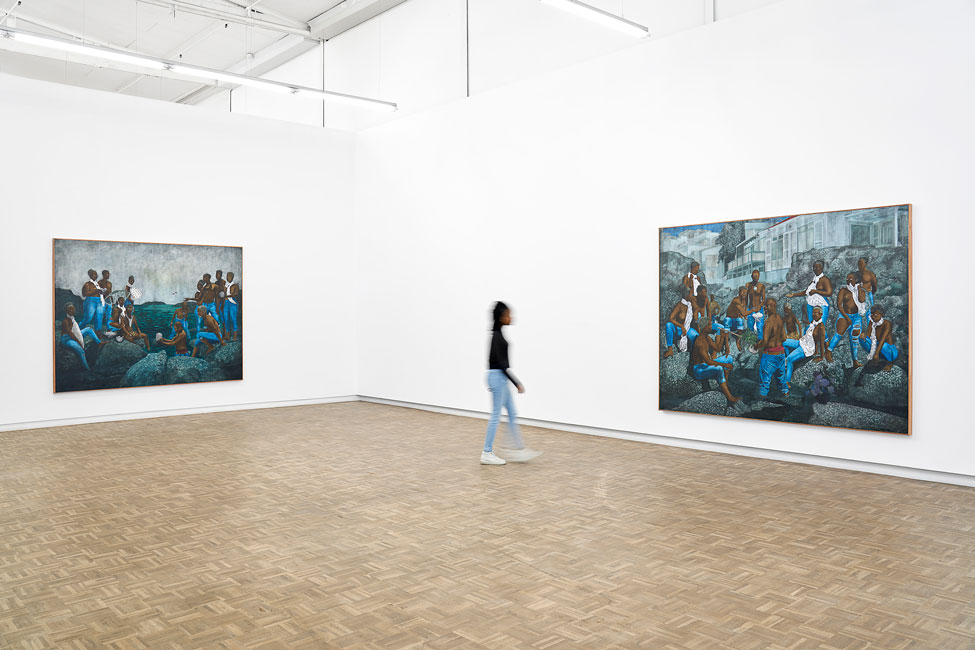

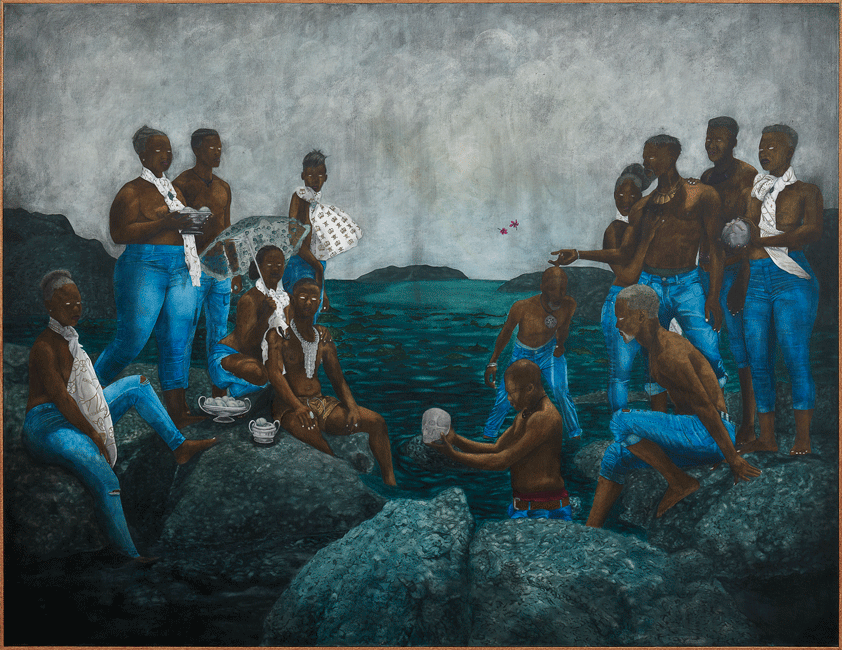



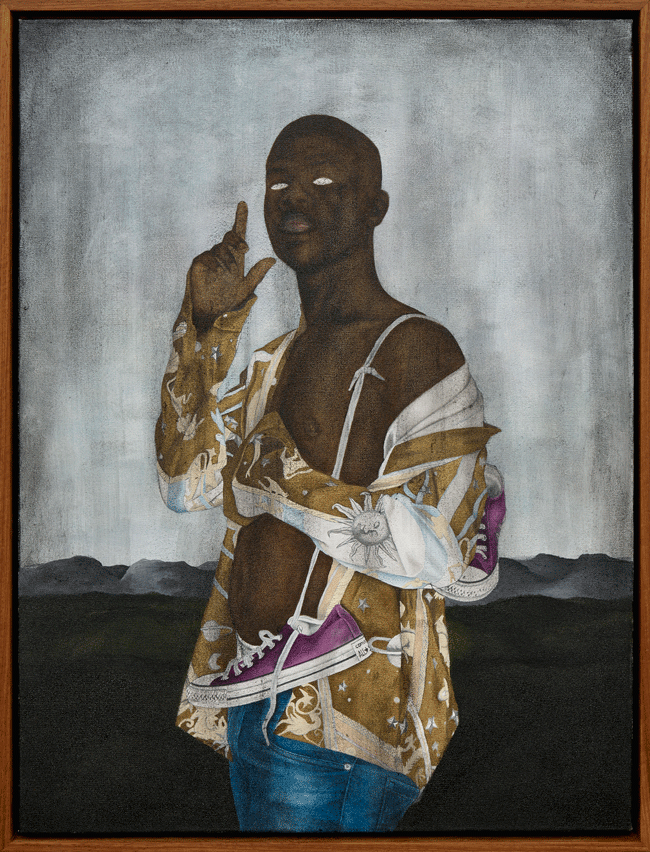

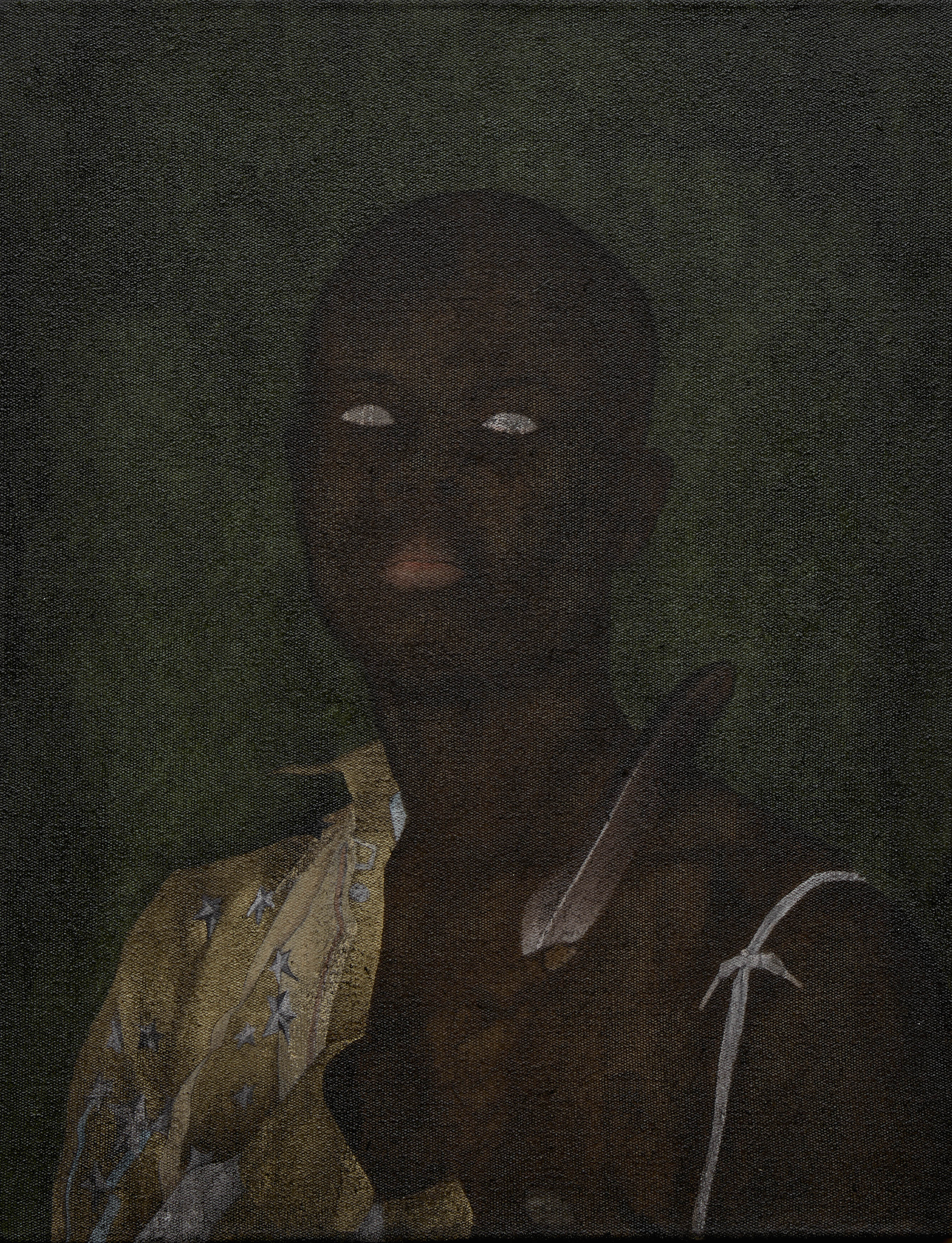
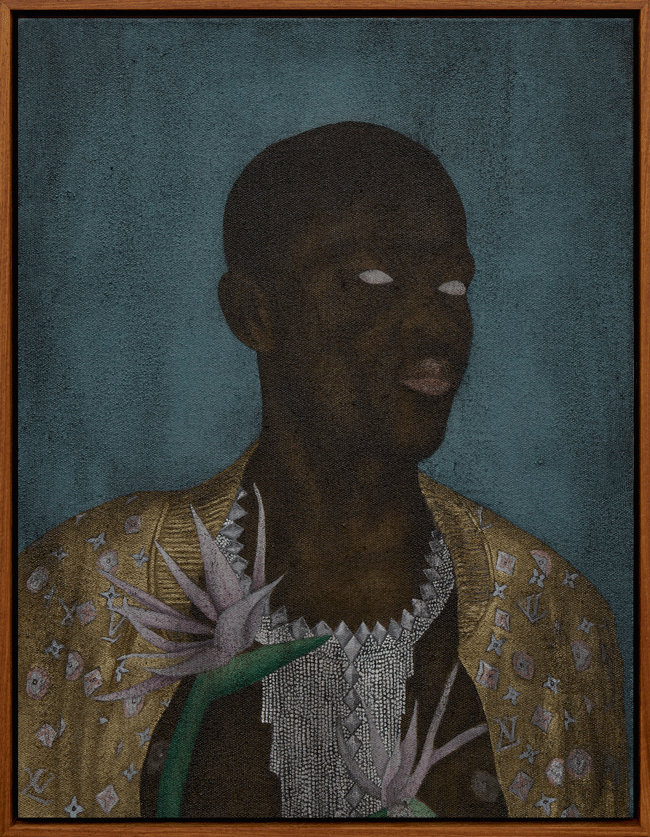

NaluLwandle, NaliKhaya by Cinga Samson
with acknowledgement to Sikhona Thutha
This passage is from the opening paragraph of The Famished Road by Ben Okri. The themes which pre-occupy this passage, i.e. temporality, mortality, and existential anxiety, are thematic concerns one finds in Cinga Samson’s body of work, centred on the human figure who is trapped in the swirl of time, in the accumulation of history, and the excesses of progress. This recalls another great African writer, Dambudzo Marechera, whose narrator in The House of Hunger says of his father’s death: “[the] twentieth-century train crunched the old man into a stain.” For the most part post- colonial African literature has always been wary of the manner in which time, disguised as history, acts on the black figure. Often, this act is revealed in the violent event. In Okri, the road, which was once a river, is always hungry. In Marechera, the century crunches the black man into a mere stain. The former writer finds a formal solution to his historical headache in the magical realism of the South American avant-garde in which time is compressed – the past in the present and the present in the past and the future as already history. The latter employs image and metaphor in a frantic stream-of-consciousness prose that assaults the reader just as it reveals the hidden violence of the English language itself. These technical devices help to realise what could be perhaps termed each author’s style. In Samson’s work, we are invited to consider style, what the artist might term beauty, as the pre-eminent concern of the pictorial drama painted on his canvas. The way a Samson painting operates is that it creates clearly delineated surfaces, along horizontal lines and geometric shapes and uses light sparingly and as unnaturally as possible. The unity of the work doesn’t rest on the gradations of light to vivify setting and to create depth. Depth is mere illusion, created by the horizontal planes, which define the foreground, landscape, and sky. However, each of these planes are dislocated and exist individually as separate points of interest on the canvas, which when taken together, formulate the whole and its unity. Each self-contained plane is aware of itself as plane, with its own modalities and peculiarities, thus claiming for the painting itself a modernist slant. For example, light… dim and murky as if it were stars mopped on the bleached fabric of the canvas, draws you into its own uniqueness. In Samson’s work, light doesn’t come from any source of direction but exists entirely as if born out of its own plane and yet its artificiality appears perfect, intentional. The same goes for the landscape, the sky, and the foregrounded figure. Even the shrubbery that is wont to be found in this artist’s work has this absurd quality and yet appears in perfect harmony with itself, firstly, and then with the rest of the elements painted along the surface. This is fresh, innocent, and unique. There are, of course, debts the artist pays to the Old Masters and early Modernists, e.g.: in the Van Eyckian figures of Northern Renaissance portraiture or the Portrait of a Young Girl by Petrus Christus; in the multiple figures on the seashore there’s a slight nod to Cézanne’s The Bathers series or a Poussin drained of dramatic action (rendered not to depict physical vitality but rather to accentuate the quiet interior life of the subject and the painting itself); and in the absence of eyes one recalls Modigliani’s Woman with Blue Eyes. So why is it that with all these debts, one is able to look at Samson’s work and be struck by its originality and singularity of vision? The answer perhaps lies in the conditions set by postcoloniality and the reactions of African writers and painters to it. Here, we’re reminded of Marechera’s unease with English – the very medium of his art: “[You] have to have harrowing fights and hair-raising panga duels with the language before you can make it do all that you want it to do…[t]his may mean discarding grammar, throwing syntax out, subverting images from within.” These subversions are all too clearly articulated in the body of work that Samson has built over this short period as a practicing artist. They are there in the structural discords, in the absurd use of light, in the individuated planes of his dimly pigmented paintings. Part of this subversion has to do with the representation of the black figure, of course. Speaking of Friday, the only black character in JM Coetzee’s Foe, the narrator (an English woman) laments: “I say [Friday] is a cannibal and he becomes a cannibal. I say he is a laundryman and he becomes a laundryman. What is the truth of Friday? No matter what he is to himself… what he is to the world is what I make of him.” Samson is keenly aware of the historical (and present) pathologies heaped upon young black men. He confronts this significance with a style that subverts the pathological with the self-reflexively beautiful… the languid form of his figure, the small pursed mouth daubed with gold paint, the stare which isn’t a stare but a seemingly piqued interest with something other than the external, the white and black of the eyes having disappeared internally, fascinated by a vast interior life of which the viewer is only allowed a glimpse of shape, form, and colour (or lack thereof). Samson’s style seems to emerge from this play: the formal discords, the painterly conversation with art history, the subversion of the black image to lend it irony and nuance. Lastly, mortality. If in the vanitas tradition the transience of life is depicted in the morbidity of the skull and the funereal opulence, in Samson’s work ephemeral materialist objects point toward well-being; an exuberance that is perhaps located within the ambiguities of black post-colonial subjectivity. The very capitalist expansion (disguised in the colonial project) holds within itself meaningful (materialist) liberatory means for the black subject, since his alienation – his marginalisation – is first and foremost a material alienation. Thus, Samson permits his figure life and livity (from the Rastafarian concept of righteous everliving living), against the vanitas’ morbid anxieties about death. NaluLwandle, NaliKhaya (Here’s the sea, Here’s home), finds Samson working closely with his younger brother, Sikhona Thutha, to elaborate on his style and vision and explore new areas and concerns. What the viewer will find novel in this show is the Cézannean congregation of figures by the sea and a harder, more graphic line within the soft silhouette that Samson has developed over the years. The illusive eerie landscapes give way to a more socially realistic setting that is bound to invite further materialist readings. But look closely at the figures at sea, at their eyeless stares, one thrown casually over the shoulder, and you’ll find the artist’s sense of irony still intact, expressed in an almost Velázquezian manner, which makes of the viewer the viewed and the viewed the viewer, thereby closing the distance between the two. It is these sleights of hand and Samson’s style and humour that never fail to make his paintings a delight to look at.
Text by Lwandile Fikeni.
with acknowledgement to Sikhona Thutha
“In the beginning there was a river. The river became a road and the road branched out to the whole world. And because the road was once a river it was always hungry. In that land of beginnings spirits mingled with the unborn. We could assume numerous forms. Many of us were birds. We knew no boundaries. There was much feasting, playing, and sorrowing. We feasted much because of the beautiful terrors of eternity. We played much because we were free.”
This passage is from the opening paragraph of The Famished Road by Ben Okri. The themes which pre-occupy this passage, i.e. temporality, mortality, and existential anxiety, are thematic concerns one finds in Cinga Samson’s body of work, centred on the human figure who is trapped in the swirl of time, in the accumulation of history, and the excesses of progress. This recalls another great African writer, Dambudzo Marechera, whose narrator in The House of Hunger says of his father’s death: “[the] twentieth-century train crunched the old man into a stain.” For the most part post- colonial African literature has always been wary of the manner in which time, disguised as history, acts on the black figure. Often, this act is revealed in the violent event. In Okri, the road, which was once a river, is always hungry. In Marechera, the century crunches the black man into a mere stain. The former writer finds a formal solution to his historical headache in the magical realism of the South American avant-garde in which time is compressed – the past in the present and the present in the past and the future as already history. The latter employs image and metaphor in a frantic stream-of-consciousness prose that assaults the reader just as it reveals the hidden violence of the English language itself. These technical devices help to realise what could be perhaps termed each author’s style. In Samson’s work, we are invited to consider style, what the artist might term beauty, as the pre-eminent concern of the pictorial drama painted on his canvas. The way a Samson painting operates is that it creates clearly delineated surfaces, along horizontal lines and geometric shapes and uses light sparingly and as unnaturally as possible. The unity of the work doesn’t rest on the gradations of light to vivify setting and to create depth. Depth is mere illusion, created by the horizontal planes, which define the foreground, landscape, and sky. However, each of these planes are dislocated and exist individually as separate points of interest on the canvas, which when taken together, formulate the whole and its unity. Each self-contained plane is aware of itself as plane, with its own modalities and peculiarities, thus claiming for the painting itself a modernist slant. For example, light… dim and murky as if it were stars mopped on the bleached fabric of the canvas, draws you into its own uniqueness. In Samson’s work, light doesn’t come from any source of direction but exists entirely as if born out of its own plane and yet its artificiality appears perfect, intentional. The same goes for the landscape, the sky, and the foregrounded figure. Even the shrubbery that is wont to be found in this artist’s work has this absurd quality and yet appears in perfect harmony with itself, firstly, and then with the rest of the elements painted along the surface. This is fresh, innocent, and unique. There are, of course, debts the artist pays to the Old Masters and early Modernists, e.g.: in the Van Eyckian figures of Northern Renaissance portraiture or the Portrait of a Young Girl by Petrus Christus; in the multiple figures on the seashore there’s a slight nod to Cézanne’s The Bathers series or a Poussin drained of dramatic action (rendered not to depict physical vitality but rather to accentuate the quiet interior life of the subject and the painting itself); and in the absence of eyes one recalls Modigliani’s Woman with Blue Eyes. So why is it that with all these debts, one is able to look at Samson’s work and be struck by its originality and singularity of vision? The answer perhaps lies in the conditions set by postcoloniality and the reactions of African writers and painters to it. Here, we’re reminded of Marechera’s unease with English – the very medium of his art: “[You] have to have harrowing fights and hair-raising panga duels with the language before you can make it do all that you want it to do…[t]his may mean discarding grammar, throwing syntax out, subverting images from within.” These subversions are all too clearly articulated in the body of work that Samson has built over this short period as a practicing artist. They are there in the structural discords, in the absurd use of light, in the individuated planes of his dimly pigmented paintings. Part of this subversion has to do with the representation of the black figure, of course. Speaking of Friday, the only black character in JM Coetzee’s Foe, the narrator (an English woman) laments: “I say [Friday] is a cannibal and he becomes a cannibal. I say he is a laundryman and he becomes a laundryman. What is the truth of Friday? No matter what he is to himself… what he is to the world is what I make of him.” Samson is keenly aware of the historical (and present) pathologies heaped upon young black men. He confronts this significance with a style that subverts the pathological with the self-reflexively beautiful… the languid form of his figure, the small pursed mouth daubed with gold paint, the stare which isn’t a stare but a seemingly piqued interest with something other than the external, the white and black of the eyes having disappeared internally, fascinated by a vast interior life of which the viewer is only allowed a glimpse of shape, form, and colour (or lack thereof). Samson’s style seems to emerge from this play: the formal discords, the painterly conversation with art history, the subversion of the black image to lend it irony and nuance. Lastly, mortality. If in the vanitas tradition the transience of life is depicted in the morbidity of the skull and the funereal opulence, in Samson’s work ephemeral materialist objects point toward well-being; an exuberance that is perhaps located within the ambiguities of black post-colonial subjectivity. The very capitalist expansion (disguised in the colonial project) holds within itself meaningful (materialist) liberatory means for the black subject, since his alienation – his marginalisation – is first and foremost a material alienation. Thus, Samson permits his figure life and livity (from the Rastafarian concept of righteous everliving living), against the vanitas’ morbid anxieties about death. NaluLwandle, NaliKhaya (Here’s the sea, Here’s home), finds Samson working closely with his younger brother, Sikhona Thutha, to elaborate on his style and vision and explore new areas and concerns. What the viewer will find novel in this show is the Cézannean congregation of figures by the sea and a harder, more graphic line within the soft silhouette that Samson has developed over the years. The illusive eerie landscapes give way to a more socially realistic setting that is bound to invite further materialist readings. But look closely at the figures at sea, at their eyeless stares, one thrown casually over the shoulder, and you’ll find the artist’s sense of irony still intact, expressed in an almost Velázquezian manner, which makes of the viewer the viewed and the viewed the viewer, thereby closing the distance between the two. It is these sleights of hand and Samson’s style and humour that never fail to make his paintings a delight to look at.
Text by Lwandile Fikeni.